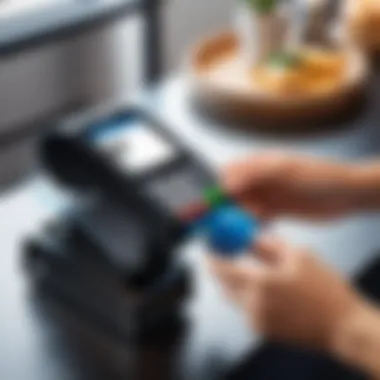Identifying the Best POS System for Small Businesses


Intro
In today’s fast-paced retail environment, having an efficient point-of-sale (POS) system is crucial for small businesses. A POS system does more than just process sales; it manages inventory, tracks customer data, and can even generate sales reports. These functionalities can significantly streamline operations and improve customer satisfaction.
For small business owners, the challenge lies in identifying a POS system that meets their specific needs while staying budget-friendly. The selection process can be daunting due to the sheer number of options available in the market. Thus, understanding the key features and benefits of various systems becomes paramount.
This article will explore the primary attributes to consider when choosing a POS system and will discuss real user experiences and peer reviews to offer valuable insights. By delineating the advantages and functionalities of leading POS systems, we aim to empower small business owners to make informed decisions that align with their operational goals and enhance business efficiency.
Understanding POS Systems
Understanding POS systems is essential for small businesses looking to optimize their operations. A robust point-of-sale system can significantly impact transaction efficiency, inventory management, and customer relations. It acts as the central hub where sales data is collected and processed, making it crucial for business success. Knowing what to expect from a POS system can ensure that small business owners choose the right one that meets their specific needs.
Definition of a POS System
A POS system, or point-of-sale system, refers to the hardware and software that facilitate transactions at retail locations and restaurants. At its core, it allows businesses to process sales, accept payments, and issue receipts. Additionally, a POS system often includes features like inventory management, customer relationship management, and analytics tools.
In essence, when customers complete their purchases, the POS system records the transaction and updates the inventory automatically. This streamlining of operations can save time and reduce the potential for errors that can arise in manual processes. Understanding this definition is a vital first step in evaluating the various systems available on the market.
Importance of POS for Small Businesses
The relevance of a POS system for small businesses cannot be overstated. Here are key reasons why these systems are important:
- Efficiency: Automating transaction processes reduces wait times and enhances customer satisfaction.
- Inventory Control: A POS system tracks stock levels in real-time, helping avoid overstock and stockouts.
- Sales Tracking: Access to detailed sales data helps businesses make informed decisions regarding product offers and staffing.
- Customer Insights: POS systems can track customer behavior, allowing businesses to tailor marketing efforts and promotions.
"Investing in a reliable POS system can be a game-changer for small businesses, enhancing both operational efficiency and customer experience."
Key Features of a POS System
A Point of Sale (POS) system's features are central to its effectiveness in managing business operations. Small businesses, in particular, require tailored solutions that can streamline transactions, oversee inventory, enhance customer relations, and provide analytical insights. The right combination of features impacts not only efficiency but also the overall customer experience. Therefore, it is crucial to understand the key features that a POS system should offer to optimize performance and meet the distinct needs of a small business.
Transaction Management
Transaction management is the backbone of any POS system. It encompasses the processing of sales transactions, including capturing payment information, applying discounts, and issuing refunds. An efficient POS should support multiple payment methods such as credit cards, mobile payments, and cash. The ability to integrate with digital wallets like PayPal or Apple Pay can provide flexibility for customers, thus enhancing their shopping experience.
Moreover, real-time transaction tracking aids businesses in maintaining accurate records. This allows for better cash flow management and reduces discrepancies during financial audits. A seamless payment process not only streamlines operations but also boosts customer satisfaction by minimizing wait times during checkout.
Inventory Management
Inventory management is another critical feature of a competent POS system. For small businesses, keeping track of stock levels, managing suppliers, and identifying best-selling products is imperative. The right system should provide real-time inventory updates, which help in preventing stockouts or overstock situations. This ensures that products are available when customers want them, thus securing sales and enhancing customer loyalty.
Integration with e-commerce platforms can further simplify inventory management. It allows businesses to synchronize online and in-store inventory effectively. Additionally, features like automated stock alerts and reorder suggestions can save time for business owners, allowing them to focus on sales rather than manual calculations.
Customer Relationship Management
Customer relationship management (CRM) features in a POS system assist businesses in building lasting relationships with clients. A robust CRM module should enable tracking of customer purchases, preferences, and interactions. This data allows for personalized marketing efforts, such as targeted promotions or loyalty rewards, which can increase customer retention.
Furthermore, a POS system that collects customer feedback and reviews can be invaluable. Understanding what customers appreciate or dislike provides insights into how the business can evolve. By responding to customer needs, small businesses can cultivate a loyal customer base that can sustain growth over time.
Reporting and Analytics
Reporting and analytics tools within a POS system empower business owners to make informed decisions. These tools can provide insights into sales trends, customer behavior, and inventory performance. For small businesses, having access to this data can highlight areas for improvement and growth opportunities.
Typically, a good POS system will offer customizable reporting options that allow users to focus on metrics that matter most to them. Examples include daily sales reports, top-selling items, or customer demographic statistics. By analyzing this data regularly, small business owners can refine strategies and maximize profitability.
"The ability to harness data from a POS system is not just a luxury; it's essential for staying competitive in today’s market."


Evaluating Pricing Structures
Understanding the pricing structures of point-of-sale (POS) systems is crucial for small business owners. The choice of a POS system can significantly affect not only the initial financial outlay but also the ongoing operational costs. By evaluating pricing structures, businesses can ensure they choose a system that offers the best value for their investment while meeting their specific needs.
Initial Costs vs. Ongoing Fees
The initial cost of a POS system typically includes hardware, software, and installation fees. For example, systems like Square or Shopify POS may present lower entry costs, as they can often function on basic mobile devices.
However, owners should be aware of potential ongoing fees. These may comprise subscriptions for software updates, features, or technical support. Understanding these costs upfront allows businesses to budget effectively and avoid surprises later.
When considering initial and ongoing expenses, it is vital to ask:
- What equipment will be needed?
- Are there setup fees involved?
- Will there be any monthly minimums or recurring subscription costs?
It's prudent to construct a breakdown of all possible costs, factoring in both one-time expenses and continuous charges. This analysis helps establish a clearer long-term financial picture and aids in avoiding overspending.
Understanding Transaction Fees
Transaction fees form an integral part of evaluating a POS system's pricing structure. These fees typically charge per transaction or a percentage of each sale. The differences can be quite substantial between providers. For example, PayPal and Stripe may charge different rates based on the total amount processed, which can add up for businesses with large volumes of sales.
"Choosing a POS system with favorable transaction fees can save businesses hundreds, if not thousands, of dollars over time."
When examining transaction fees, consider:
- How does the fee structure work?
- Are there discounts available with higher volumes?
- Are there additional fees for chargebacks or refunds?
Understanding these elements will enable small business owners to make more informed decisions. It allows them to balance out transaction costs against the features and support they will receive; thus ensuring a good alignment of service and expense.
Integrations and Compatibility
In the current technology landscape, having a point-of-sale (POS) system that integrates well with existing software and hardware is crucial for small businesses. This capability not only enhances efficiency but also streamlines operations, allowing business owners to focus more on customer satisfaction and growth. Poor integration can lead to data silos, operational inefficiencies, and ultimately, lost revenues. Thus, understanding the importance of integrations and compatibility should be a key consideration when selecting the right POS system.
Third-Party Software Integrations
A robust POS system should offer compatibility with various third-party software applications. These integrations can range from accounting software like QuickBooks to e-commerce platforms like Shopify. By enabling seamless data flow between systems, businesses can eliminate manual entry, reduce errors, and obtain real-time insights.
Some points to consider include:
- Accounting Software: Linking your POS with accounting tools helps automate financial record keeping. This can save time and mitigate the risks inherent in manual data entry.
- CRM Systems: Integrations with Customer Relationship Management software can enhance customer insights and improve communication strategies.
- Inventory Management: If your POS does not support integration with inventory tools, you may face challenges in keeping stocks updated.
- E-commerce Platforms: Many businesses operate both in-store and online. A POS that integrates with these platforms means you can manage sales, returns, and inventory from a centralized location.
Ensuring that your POS can connect with essential software improves scalability and adapts to changing business needs.
Hardware Compatibility
Not all POS systems work with every piece of hardware. Before selecting a system, assess its compatibility with existing equipment. Most businesses rely on devices like barcode scanners, receipt printers, and cash drawers for daily operations. Consider the following factors:
- Existing Equipment Compatibility: Verify if the POS system you consider can easily integrate with your current hardware. This can save you significant expenses related to purchasing new devices.
- Software Updates: Some POS systems may be incompatible with older hardware after software updates. This is especially important for businesses planning to scale in the future.
- Mobile Compatibility: With the rise of mobile payments, ensure that your POS can process transactions from mobile devices. This capability can enhance customer convenience and provide more payment options.
Ensuring strong hardware compatibility protects your investment by extending the lifespan of your current equipment while allowing you to upgrade without significant disruption.
"Integration is not just about combining systems; it’s about creating seamless workflows that save time and drive growth."
User Experience and Support
User experience and support play a critical role in selecting a point-of-sale (POS) system for small businesses. A good user experience can significantly streamline operations and enhance productivity. This aspect is not merely about aesthetics but encompasses how intuitive and functional the system is for day-to-day tasks. Small business owners need a system that their employees can quickly adopt without extensive training. Systems lacking usability may lead to frustrating experiences, hindering customer service and daily operations.


Effective support is equally important. Small businesses often encounter issues that require immediate resolution. Without reliable customer support, these problems can disrupt business flow, impacting overall efficiency and customer satisfaction. Thus, understanding the availability and quality of support services is crucial when evaluating a POS system.
Ease of Use
The ease of use of a POS system is paramount for small businesses. Employees should navigate the system with minimal hurdles, providing a smoother checkout process. This is especially important during peak hours when efficiency is vital.
A POS system should have a logical layout and straightforward features. Ideally, new staff should be able to learn to use the system quickly. Some elements to consider include:
- User Interface: A clean and organized user interface makes the system easy to navigate.
- Customization Options: Systems allowing businesses to tailor features to their needs may enhance usability.
- Mobile Functionality: Given the rise of mobile solutions, a POS system equipped with mobile capabilities can greatly improve user experience, especially in retail environments.
Implementing a POS system that prioritizes ease of use can result in brisker customer interactions and less training time for employees.
Customer Support Options
Customer support is a foundational element that can determine the long-term success of a POS system. As small businesses may face unique challenges, having access to responsive and knowledgeable support can mitigate disruptions.
When evaluating customer support options, consider the following:
- Availability: Determine if support is available 24/7 or only during business hours. Round-the-clock support may be necessary for businesses operating extended hours.
- Communication Channels: Multiple avenues for support—such as phone, email, and live chat—allow businesses to reach assistance quickly. Some systems even have community forums for peer support.
- Response Times: Fast response times can minimize downtime when issues arise. Check user reviews to gauge past customer experiences.
In summary, both user experience and support are vital components in assessing POS systems for small businesses. A focus on these areas can lead to operational success and improved customer satisfaction.
"Choosing a POS system is not just about the features; it's about how well those features work together to create an efficient process for both employees and customers."
For more information, you may explore resources like Wikipedia or check community discussions on Reddit.
Top POS Systems for Small Businesses
Selecting the right point-of-sale (POS) system is crucial for small businesses. These systems not only manage transactions but also integrate multiple aspects of business operations. By examining different POS options, business owners can find a system that meets their specific needs, ultimately enhancing productivity and customer satisfaction.
System A: Overview and Features
System A stands out in the POS landscape, primarily due to its user-friendly interface and comprehensive feature set. It is designed to cater to small businesses across various sectors, including retail and hospitality. Key features of System A include:
- Inventory Management: This feature allows real-time tracking of stock levels and automated restocking alerts, minimizing the risk of running out of essential items.
- Sales Reporting: Users can access detailed sales reports that highlight peak hours, popular items, and customer purchasing patterns. This data is vital for strategic business decisions.
- Customer Profiles: System A supports creating and managing customer profiles for tailored marketing efforts and enhancing customer service.
System B: Overview and Features
System B is another viable option for small businesses. It focuses on flexibility and adaptability, making it suitable for various operational styles. Its notable features include:
- Multi-store Capability: Ideal for businesses with multiple locations, allowing centralized management from a single device.
- Mobile Compatibility: This system enables sales to be processed through mobile devices, which is beneficial for businesses that operate on-the-go.
- Loyalty Programs: Built-in tools for creating loyalty programs encourage repeat business by rewarding customers.
System C: Overview and Features
System C brings an innovative approach tailored specifically for service-oriented businesses like salons and restaurants. Key benefits of System C are:
- Appointment Scheduling: Integrated scheduling tools allow customers to book appointments directly, streamlining operations.
- Table Management: For restaurants, the system provides a layout of tables, making reservation and seating management seamless.
- Enhanced Payment Options: System C supports various payment methods, including contactless payments, which is becoming crucial in today's market.
"The right POS system can transform the way you handle transactions and manage your business."
Each system provides unique features that cater to distinct business needs. Choosing a suitable POS system is not just about handling sales; it's about creating an integrated approach to managing various facets of business operations.
Peer Reviews and User Experiences
Understanding peer reviews and user experiences is crucial when identifying the best POS systems for small businesses. This section highlights the significance of gathering real-world insights from current users and industry experts.


Reviews can offer invaluable information about a system's functionality, reliability, and overall effectiveness. They serve as a powerful tool for small business owners seeking to make informed decisions. User experiences often highlight specific strengths and weaknesses of a system that may not be apparent through marketing materials alone.
Additionally, the collective feedback from other users can help normalize expectations regarding performance. It can unveil potential issues based on actual usage, which can help in making a balanced comparison between different POS systems.
Moreover, online platforms like Reddit or Facebook provide space for discussions and clarifications. Engaging with these communities can produce a well-rounded view of each system's user satisfaction and adaptability. This feedback is pivotal in establishing trust in a product before any substantial investments are made.
Collecting User Feedback
To collect user feedback effectively, it is important to utilize a variety of channels. Surveys can capture broad sentiments and quantitative data about user experiences. Systems like Google Forms or SurveyMonkey can help in efficiently gathering opinions.
Social media platforms are also useful. Engaging with specific groups aligned with your industry can facilitate direct feedback. Customers may share their experiences on forums or platforms dedicated to reviews.
In particular:
- Look for reviews on websites like Capterra or G2.
- Use social media to perform informal polls or discussions.
- Track mentions of your chosen systems in relevant online communities.
This multitude of methods provides depth to feedback collection. Don’t just focus on positive reviews; understanding reasons behind negative feedback is equally important.
Analyzing Real-world Applications
Analyzing real-world applications of POS systems enhances understanding of their practical use. It helps in dissecting how a system performs in actual business conditions, rather than hypothetical scenarios. Case studies and testimonials provide context to user feedback, facilitating clearer insights.
Consider examining how different businesses implement specific systems. For instance, a retail store might value inventory tracking features more than a restaurant, which could prioritize speed of service.
When analyzing applications, pay attention to:
- Specific features utilized by businesses in various sectors.
- The adaptability of the system for different business size and needs.
- Support resources available post-implementation.
"Real experiences from other small businesses can guide a potential buyer in evaluating if the system will meet their unique requirements."
By carefully analyzing both user feedback and real-world applications, small business owners can position themselves to select systems that not only fit their immediate needs but also align with long-term business goals.
Future Trends in POS Technology
The landscape of point-of-sale (POS) technology is evolving at an unprecedented pace. As small businesses navigate a competitive marketplace, staying informed about future trends becomes crucial. Understanding these developments can empower business owners to make informed choices that enhance operational efficiency and customer satisfaction. This section focuses on specific advancements in POS technology, the benefits they offer, and key considerations that will shape the future of small business operations.
Emerging Technologies
Emerging technologies are redefining how POS systems operate. From cloud-based solutions to artificial intelligence, businesses are gaining access to tools that provide enhanced functionality and flexibility. Here are some notable trends:
- Cloud Computing: Cloud-based POS systems allow businesses to access data from anywhere. This flexibility is essential for small operations that need real-time insights into transactions and inventory.
- Mobile Payments: The rise of mobile payment options, like Apple Pay and Google Wallet, provides customers with convenient ways to pay. Integrating these options can increase sales and improve customer experience.
- Artificial Intelligence: AI can automate many processes, from inventory management to customer engagement. Predictive analytics powered by AI can help businesses forecast demand and tailor marketing strategies.
- Contactless Technology: The use of tap-to-pay technologies has surged. This trend not only enhances customer safety but also expedites the checkout process, which is vital for high-traffic establishments.
These technologies not only streamline operations but also provide small businesses a competitive advantage in the market.
Impact on Small Businesses
The impact of these technological advances on small businesses is profound. Here is how adopting these trends can benefit smaller operations:
- Increased Efficiency: Automation of repetitive tasks allows employees to focus on more strategic aspects of the business. For instance, using AI for scheduling can significantly cut down on administrative overhead.
- Cost Reduction: Cloud-based systems often come with lower upfront costs compared to traditional systems. Additionally, they minimize the need for on-premise hardware and maintenance.
- Improved Customer Insights: Modern POS systems can collect and analyze customer data. This information helps small businesses tailor services and products to meet specific consumer needs, leading to enhanced customer satisfaction.
- Agility in Adapting Market Changes: With the ability to quickly access and analyze data, small businesses can adapt swiftly to market trends and shifts, ensuring they remain relevant.
"The integration of new technologies into POS systems is not merely a trend; it is essential for survival in today’s fast-paced business environment."
As small businesses continue to integrate these advancements, the ultimate goal remains to improve efficiency, reduce costs, and enhance customer experiences.
End
A POS system streamlines processes, reduces human error, and offers valuable insights through analytics. These insights can help business owners make informed decisions and enhance profitability. Furthermore, considering specific elements such as cost, usability, and integrations is essential. These factors play a pivotal role in how well a POS system will fit into the existing business framework.
Moreover, understanding user experiences and peer reviews provides deeper context. It allows potential users to grasp practical applications and potential challenges associated with different systems. This type of qualitative data proves invaluable in the decision-making process, offering perspectives that technical specifications alone cannot convey.
Thus, acknowledging these considerations is paramount. A suitable POS system should align with the unique needs of the business. This alignment not only facilitates smoother operations but can also foster growth in an increasingly competitive marketplace.
Emphasizing a thorough evaluation ensures small business owners can derive maximum value from their chosen system, ultimately supporting their long-term success in a complex retail environment.



